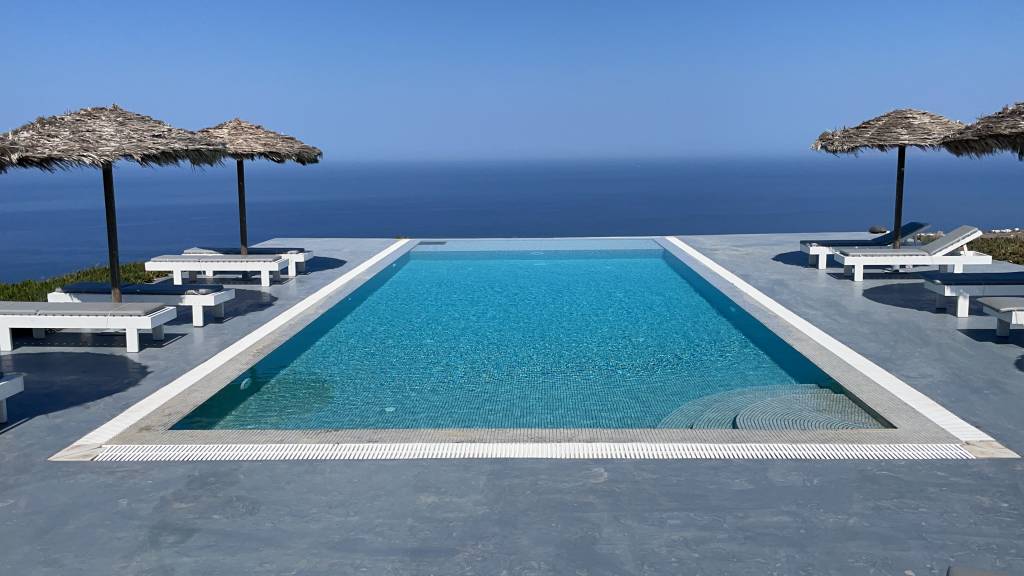
The pool at Eos Villa, Imerovigli, Santorini, Greece
Been back a week from a long-planned two-week trip to Greece. This was a risk – booked in April before the coronavirus Delta variant had emerged with ferocity. I’ve written dozens of articles about covid and believed that vaccinations would be decisive. And they were – against D614G and against Alpha. But Delta would be a different story. I convinced old friends living in Germany and Ireland that, by late July-early August, vaccination rates would be up and cases would be down. We all rolled the dice, and we got lucky.
First, news one might use (some applies to international travel in general):
Greece is more or less infernally hot during the summer months (I have now learned, from experience, the handy conversion of 40 degrees Celsius being 104 degrees Fahrenheit), and lacks the diurnal (day-night) temperature swings familiar to a place like Denver. In Greece, we had highs in the 90s to 100s and lows in the lower 80s to upper 70s. I brought nothing warmer than a long-sleeve T-shirt, and I never unrolled it.
Avoid the ubiquitous and tourist-centered Euronet ATMs (Euronet, I now see, is based in Leawood, Kansas, of all places). These will give you about a 10% lesser exchange rate and then ding you with a 13.5% fee on top of that. I tended to go with Piraeus Bank. That said, while Piraeus’s exchange rate was only a percentage point or two lower than those you’ll see on Google Finance, they took an 8.5% fee. My understanding is that arranging for euros with your own bank prior to departure is the most economical way forward.
Credit cards are widely accepted, and I did my level best to go with credit where possible (at restaurants, I’d tip in cash).
Speaking of, while the approach seems to differ here and there, the most typical one at restaurants is to get the bill from the wait staff and then take it up front to pay. I’d then leave the tip (5-10% suffices) on the table or hand it to the wait staff.
Taxis do not, as far as I can tell, take credit cards. So if you fly into Athens, you’ll want to make sure you have about 40 Euros handy to cover the flat-fee 35 Euro fare to downtown (49 euros between about midnight and 5a) upon landing. There’s a Euronet ATM in the airport.
If you tour by car, every freeway is a toll road. We found these useful in breaking 50 euro notes spit out by Euronet and other ATMs.
Anyone under 25 gets half off (or more) at the major museums – you need a European student ID or a passport handy is all. Most museums are 12 euros, 6 euros with the discount.
Covid: As of August 2021, proof of vaccination got you into Greece. We transited through Toronto in such a way that the Canadians essentially pretended we were never there.
Upon return to the United States, you needed a negative PCR or antibody test taken within 72 hours of departure even if vaccinated (bring your vaccination card, obviously). We did this with BinaxNOW (Abbott Labs) tests we brought along. These are proctored through an online connection (one needs a video-capable device such as iPad in addition to one’s phone, because the phone has the Navica app that will receive the test results… it’s slightly complicated). That said, it’s not hard to find someone willing to take 35-90 euros from you for onsite testing in Greece.
If you take the slow ferry (such as the Blue Star Delos) from Athens/Piraeus to the islands departing in late July-early August, get yourself a cabin as the ship will be mobbed. But the slow ride a good way to spend the day while transporting oneself.
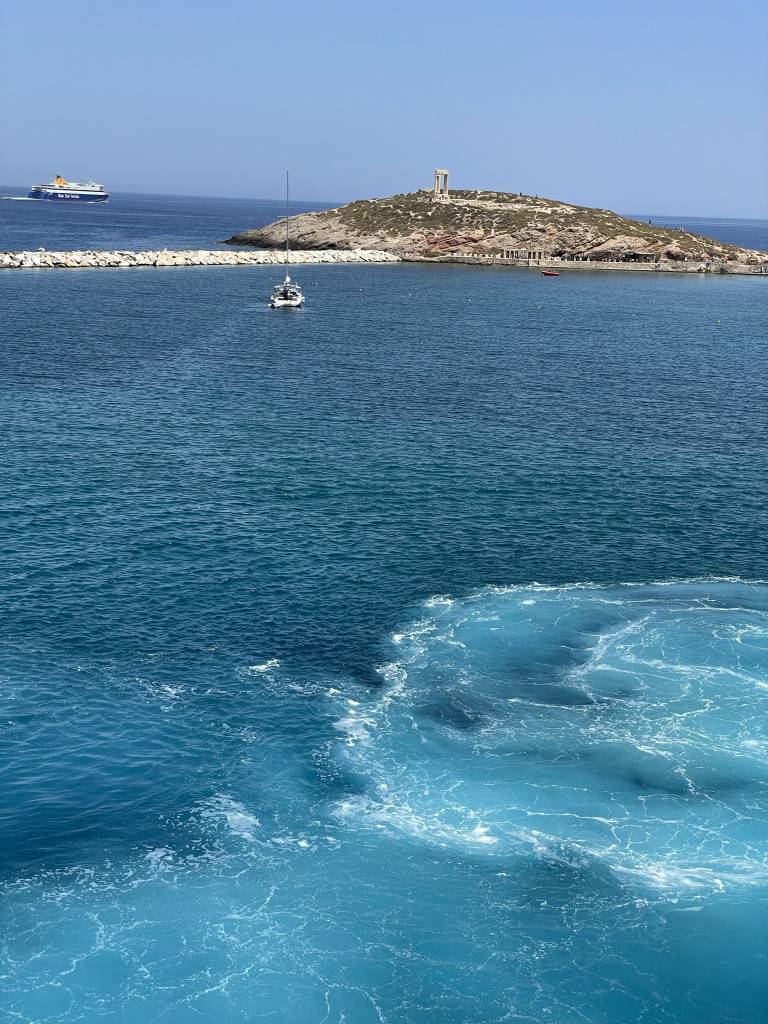
The Temple of Apollo from the vantagepoint of the Blue Star Delos
The fast ferries go like 45-50 mph, and the crew shoos you in from the back deck after each stop for fear that you’ll blow right off into the Mediterranean. A cabbie in Athens also noted that, if the seas are rough, the high-speed catamarans bounce around a lot. We did take a fast ferry back to Athens – the Seajets WorldChampion. Once held the world record for the longest distance traveled by a passenger ferry in 24h – 1,063 sea miles. How ‘bout that….
That might be all the news you can use.
Oh: If you’re plotting a trip and are on the fence, Greece is relatively quiet at the moment due to the complete absence of Chinese and Japanese tourists and reticence among many others. I heard a whole lot of French as well as some Italian and Spanish, plus some German, Dutch, and Danish; British English here and there; and American accents rarely.
Some thoughts after a couple of weeks in Greece:
We saw our first cloud 13 days into a 16-day stay.
We rented a car and looped up to Delphi (really something), then down to the Peloponnese, where we stopped by Ancient Olympia en route to the Odontotos railway and then Nafplio. Then back to Athens and out to the island of Santorini for a solid week with a bigger group of European pals. In Athens, we splurged on the Elia Ermou (“Elia” means “olive”; Ermou is the mall of a street that runs into Syntagma Square – great location not far from the Plaka; brilliant included breakfast up on 7F with Parthenon views; hot tub that is for show only, as far as we could tell). We left our bags in the room upon arrival, headed up to the Acropolis, and had an early, groggy dinner at an outdoor spot on the way back down.
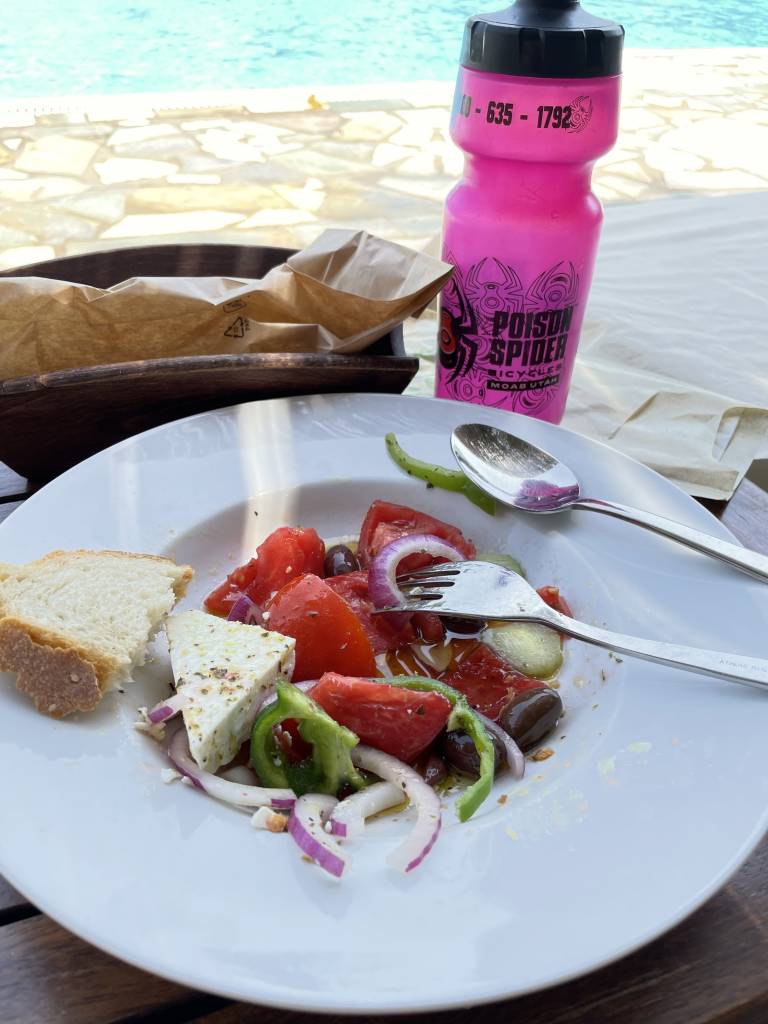
A representative Greek salad with an unrepresentative beverage container
Food was superb wherever we went. Greek salads to die for, each with its own twist, typically with about a pound of feta, tomatoes you’d have to grow yourself here, and red onions that are somehow sweet (cucumber just cucumber – cucumber always being just cucumber).
Delphi is much more than ruins. Lovely town high on the slopes of the Parnassus overlooking valleys full of olive trees. But the ruins themselves are fascinating, and the museum is small and manageable but world-class. Stayed at the completely adequate and not expensive Pan Hotel. There are dozens of hotels to choose from, and a slew of restaurants. But the pandemic has clearly taken its toll.
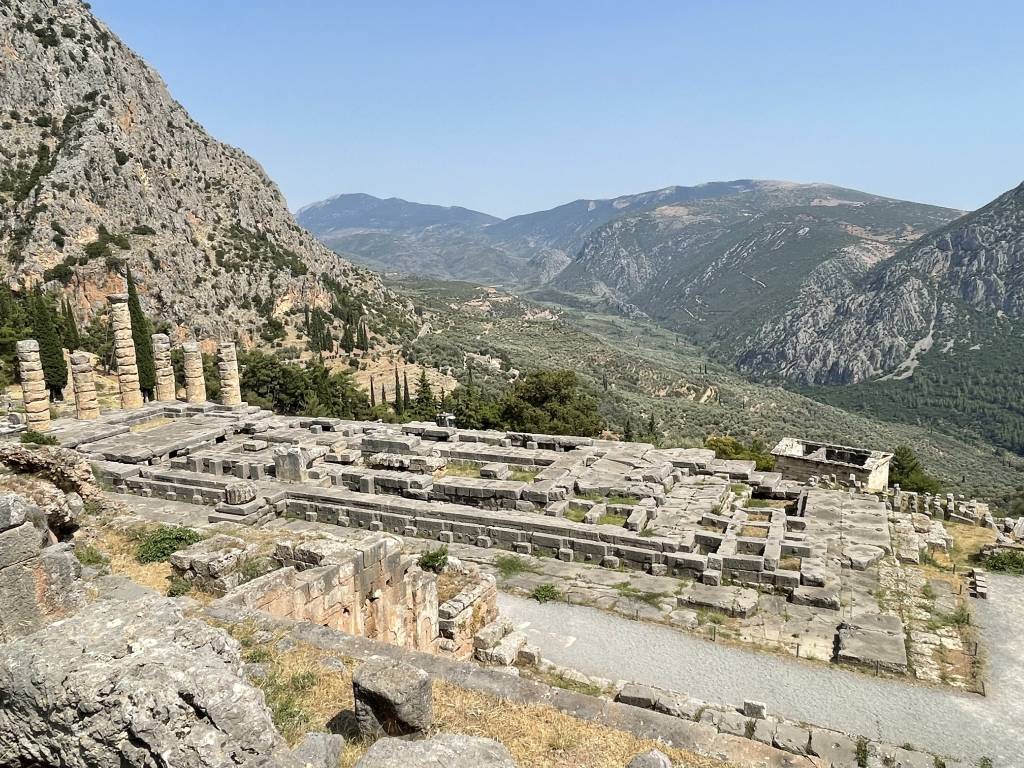
The ruins at Delphi. Note olive trees in valley.
The Delphi-Olympia drive pushes 3h, but the first half weaves along the shores of the sea and the second half chugs you through the agricultural heartland (we passed many trucks piled high with tomatoes destined for Greek salads).
Ancient Olympia’s town is less interesting than Delphi, but the ruins and the museum – particularly the Archaeological (main) museum, are superb. We stayed at another splurge hotel, the Hotel Europa. Great pool and an outdoor restaurant (The Garden Tavern) under olive trees that looks out over square miles of groves below. If you stay there, eat there. The breakfast was also pretty amazing. In general, the included breakfast at a good Greek hotel has much more in common with an American Sunday brunch than with the halfhearted, paper-plate carb-fests of most American-hotel offerings.
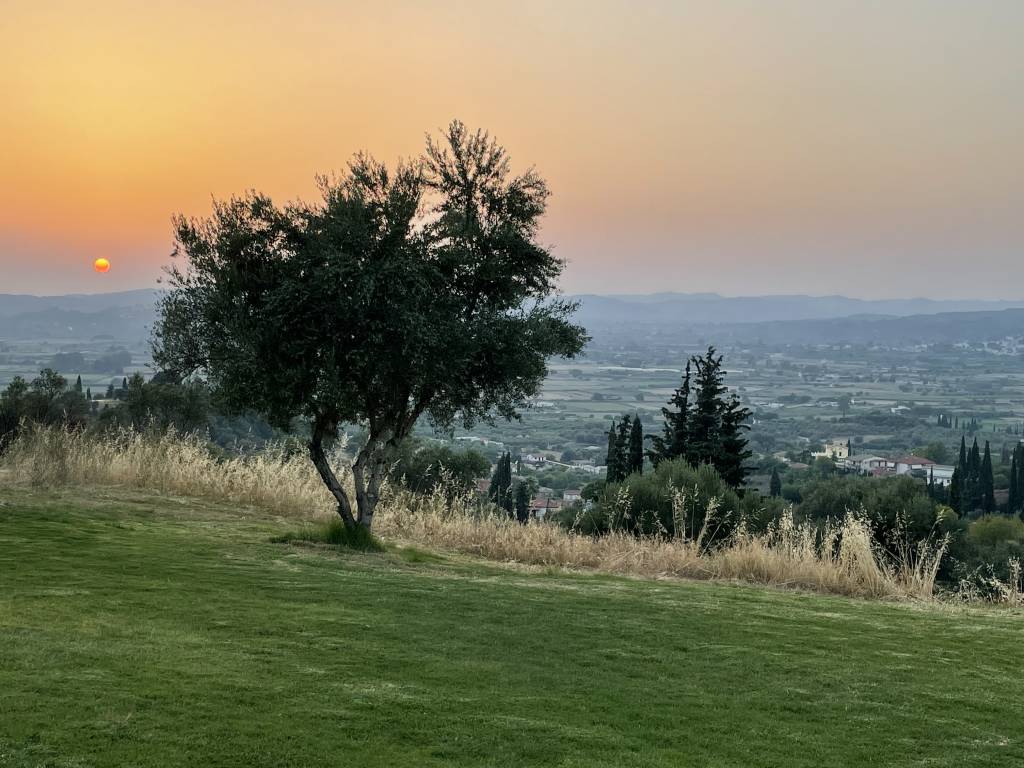
View from the Europa Hotel outdoor tavern at sunset, not Photoshopped, swear to God
We then drove the couple of hours to Diakopto/Diakofto (your choice), where we took the Odontotos narrow-gauge railway up to Kalavyrta. Besides the railway, there’s not much for the tourist in Diapopto. This was probably the weak link of our trip, but that’s largely because we in Denver live a short drive from the mountains, and the astonishing scenery in the national park this train winds (and drills) through seemed oddly familiar at times. Book seats 5-8 to be up front on the way up, and keep in mind that banks of seats face each other in groups of four. We had somewhat less than 3.5 hours of stuff to do in the pleasant ski town of Kalavyrta until the return trip, but made due. Had it not been like 38C/100F, might have gone for a hike or similar. But did have lunch at one of the many outdoor spots, and the Holocaust museum is well worth a visit. This museum is somewhat misnamed for those of us who think systematic, industrial-scale genocide when we hear “Holocaust” – basically the fucking Nazis massacred hundreds of men and boys in late 1943 as part of a military operation gone way, way overboard. But interesting artifacts and well presented.
We then drove the roughly 2h to Nafplio. This is a town I sort of stumbled into, and its phenomenal. Lovely harbor and harborside restaurants, multi-street pedestrian-only shopping district, a Venetian fortress 1,000 steps up, beaches walkable or short drives away… great place to spend a couple of days. The Leto Nuevo Hotel was just uphill from the heart of the old city, stylish, clean, cool and comfy. And yet again, a great breakfast.
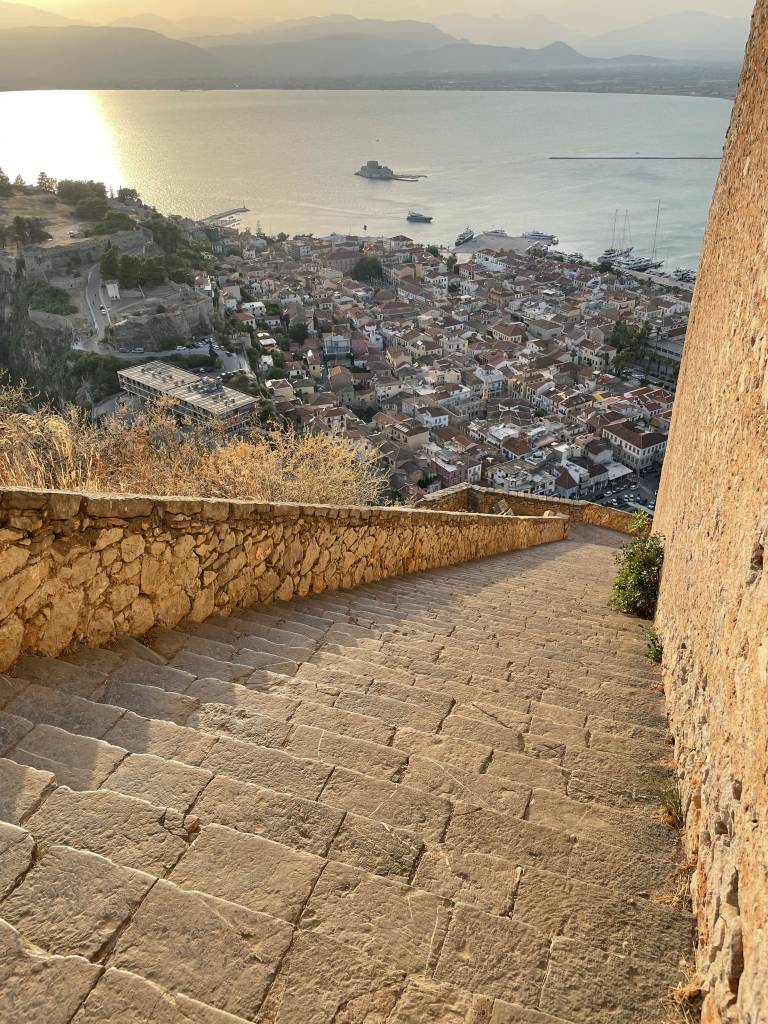
View from partway up the stairs to the Palamidi Fortress in Nafplio. If you’re in reasonable shape, 20 minutes and you’re up there, no problem (though you may sweat — I did, but it was 102 degrees out). Catch the stairs across the street from the park (there’s a Roman gate in this park) south of the Nafplio Courthouse. Or it’s probably 200 meters northeast of Arvanitas Beach. Google Maps shows the staircase as a dotted-line squiggle.
Yes. And then Santorini.
Santorini felt crowded and chaotic, so it was something of a shock when a merchant mentioned that the place was at about 40 percent capacity. I would not want to be there, however lovely – and it’s breathtaking, this island – at even 80%.
We rented a car, dodging quads and scooters on streets designed for donkeys walking single-file. I don’t believe there’s a traffic light on the island. We were a group of 14, three families and a couple of boyfriends of the oldest of the kids, all stemming from my exchange year in Germany in 1985-1986.
A group that size has the disadvantage of having to find lodging for 14 and the advantage of having significant purchasing power. We ended up at Eos Villa, about an eight-minute walk downhill from Imerovigli, a town between the more famous Fira and Oia. The place was on the not-caldera side, so there was space, and it had a pool… well, here’s a photo.
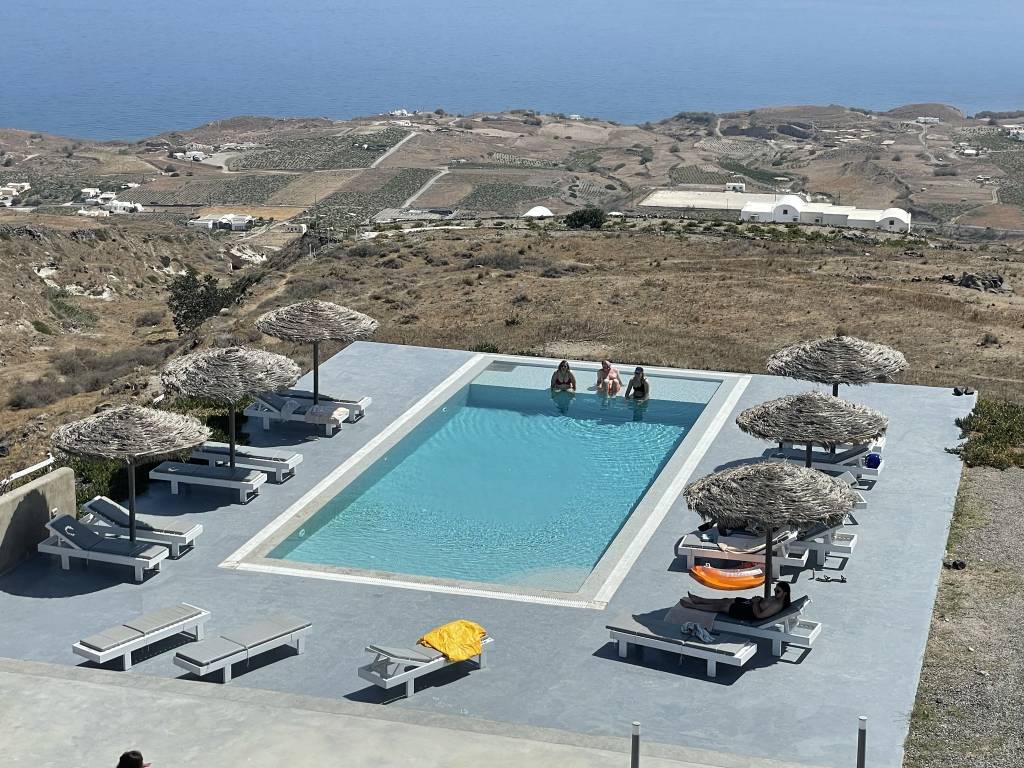
View from the Eos Villa balcony
It was as good as it looks. The kind of place you look of the pool deck or balcony off and say to yourself, “I can’t believe this shit.”
If you’re staying at an Airbnb type place with a big group on Santorini, you’ll want at least one car (cabs are erratic and pricey) to get to the grocery stores, which are 4-5 km and 200 turns away. AB is a bit better than Lidl which is a bit cheaper than AB. There are also lots of small “Super Markets,” which are convenience stores.
What else? If you can afford it, do a half-day (5h) cruise on a sailboat whose sail never really gets unfurled. They’re about $175 a nose but well worth it. Certainly the absolute highlight; the Eos Villa concierge Katharina arranged it with Vista Yachting. She also arranged a fabulous wine tasting at Argyros (40 euros per person; one of our party, a wine connoisseur who has done I’d guess 100 tastings or more over the years, said it was the best he’d ever experienced), followed by dinner overlooking Fira at Pyrgos (great food, great views, reasonably priced).
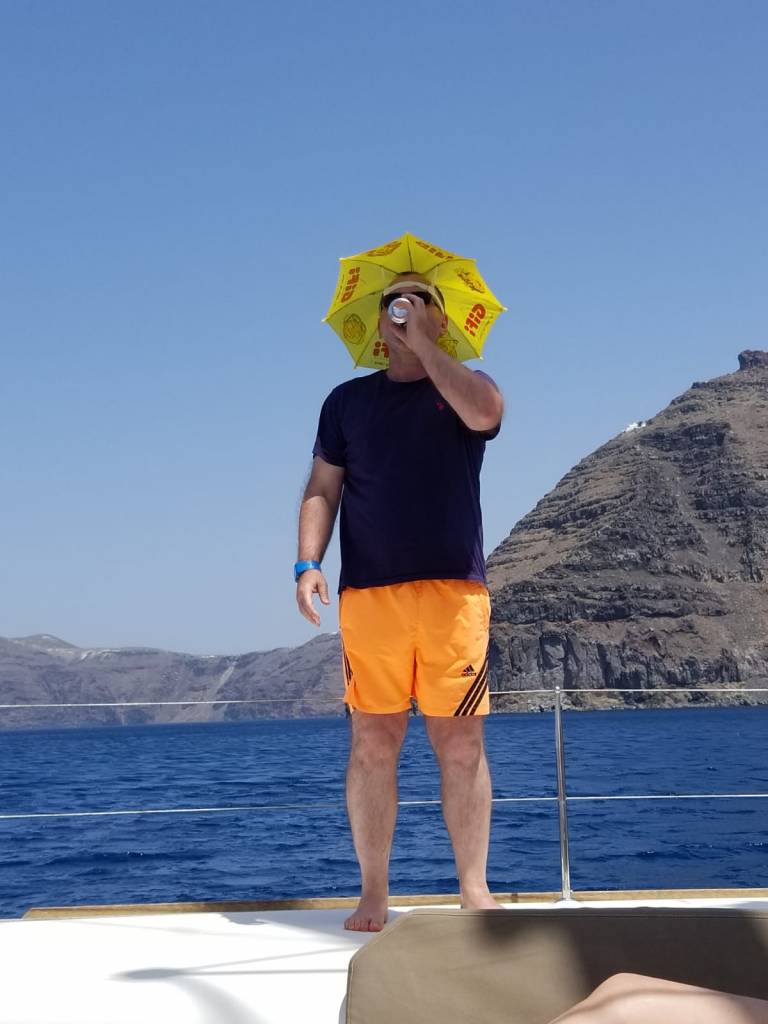
The only risk of taking a day cruise from Santorini is you may end up on the boat with this guy.
I ran about half the Imerovigli-Oia hiking trail on three occasions; had to walk-run some of it as you’re talking 20% grades. Absolutely grueling; totally stunning and worth it. If you’re going to hike it all the way to Oia, start early and bring water.
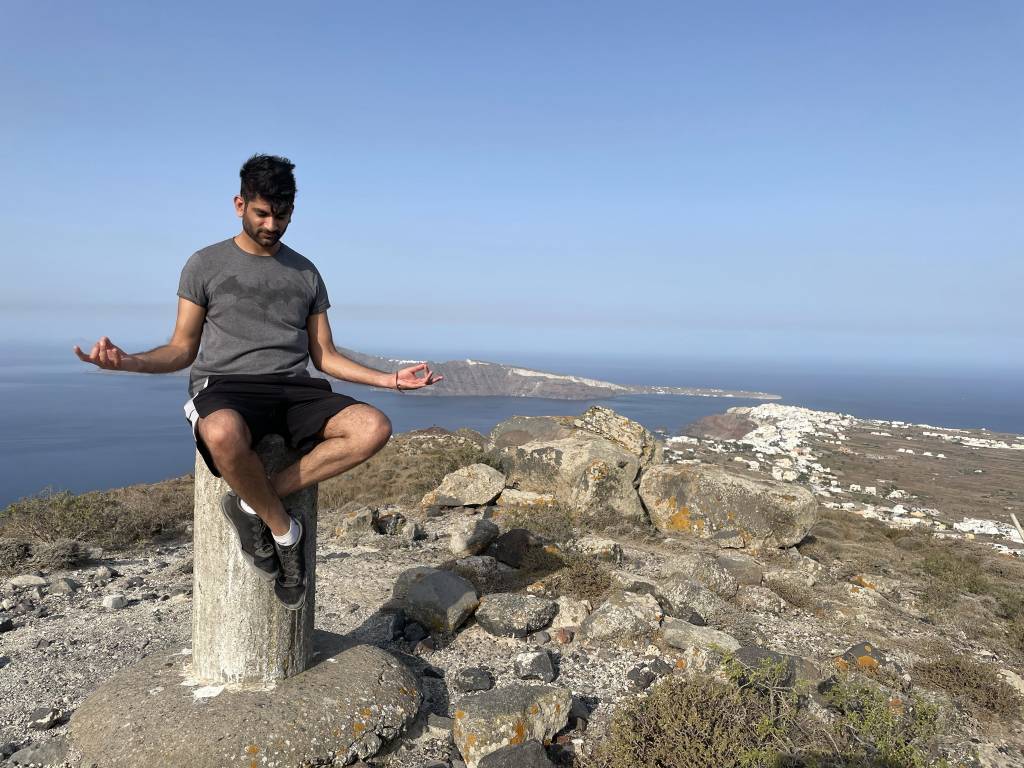
About three miles from Imerovigli on the trail to Oia, you’ll come across a classic white/blue Greek Orthodox church, and from there, you’re a few steps from one of the island’s peaks where this sort of view presents itself. Pavan Kareer not included.
Spent a smoldering afternoon at Oia, the most picturesque village I’ve ever seen (been to 40+ countries). Ludicrously beautiful people in statistically improbable numbers, many wearing cocktail-dress or whatever attire entirely unsuited to 40C. After walking by one such specimen, I said aloud, “Must be a runway model,” to which my daughter corrected, “No, she’s too short to be a runway model. Probably an Instagram influencer.”
When the island of Santorini blew its stack in 1600 BC, it buried in ash – and preserved, Pompei-style – the Minoan city of Akrotiri. This archaeological site plus a swing by the Red Beach consumed one midday excursion. The ruins themselves have an expansive roof over them (and thus not broiling hot). The visit makes all the more worthwhile the swing through the Athens National Archaeological Museum’s Akrotiri exhibit, where the wall murals and pottery (pottery that could have been fired a week ago last Thursday by its looks) have landed.
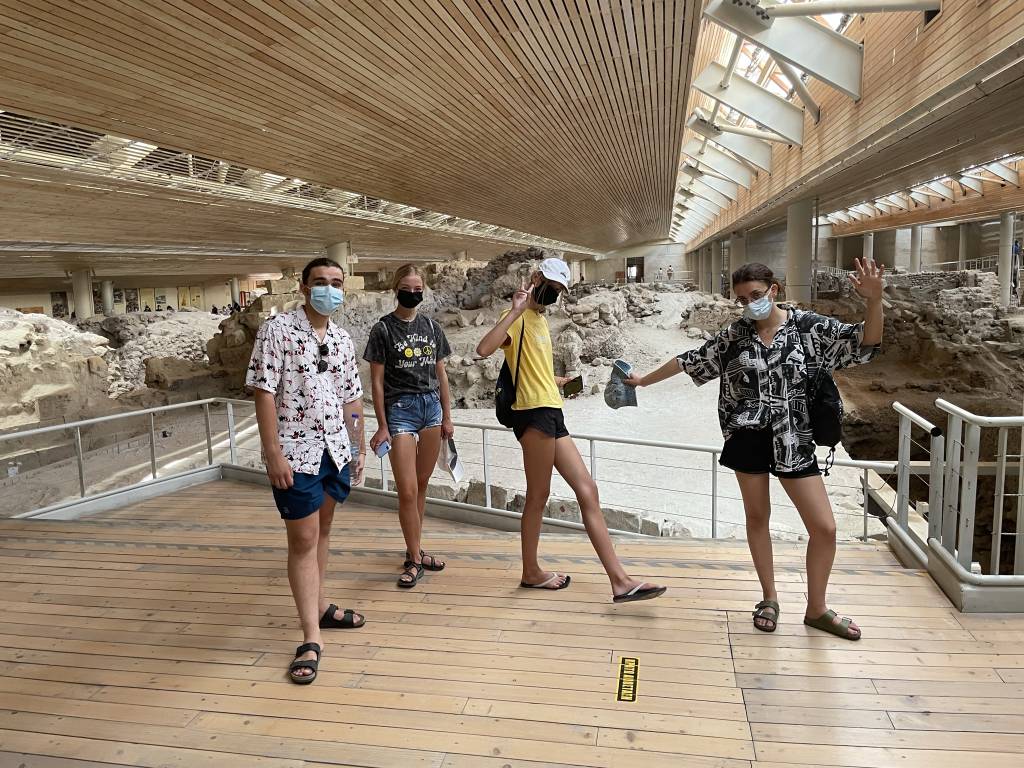
Not-so-ancient visitors to the ancient ruins of Akrotiri. Apparently the Archaeological Museum of Thera on Santorini also has murals, pottery, and other artefacts that offer a true sense of the talents of the inhabitants of these blocky structures buried 3,700 years ago.
A trip to Kamari Beach consumed another midday excursion consisting of some souvenir shopping, a beachside-restaurant lunch, and a swim. Rocky entry and hot sand make beach shoes, which we didn’t have, advantageous.
Yeah, and we chilled by the pool and drank a lot of Mythos beer (personal favorite among the Greek varieties) and wine and Ouzo and Metaxa and so on. And back to Athens and out again. Despite pricing being reasonable from a Denver perspective, it all cost a small fortune. But man, was it worth it.
